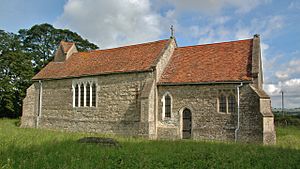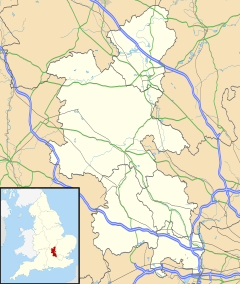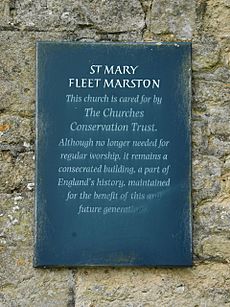Fleet Marston facts for kids
Quick facts for kids Fleet Marston |
|
|---|---|
 St Mary's parish church |
|
| Population | 47 (Mid-2010 estimate) |
| OS grid reference | SP7716 |
| Civil parish |
|
| Unitary authority |
|
| Ceremonial county | |
| Region | |
| Country | England |
| Sovereign state | United Kingdom |
| Post town | Aylesbury |
| Postcode district | HP18 |
| Dialling code | 01296 |
| Police | Thames Valley |
| Fire | Buckinghamshire |
| Ambulance | South Central |
| EU Parliament | South East England |
| UK Parliament |
|
Fleet Marston is a small area in Buckinghamshire, England. It's about 2.5 miles (4 km) northwest of Aylesbury. It's known as a civil parish, which is a local government area, and also as a deserted medieval village. This means it was once a busy village in the Middle Ages but is now mostly empty.
The area is quite long from north to south, but narrow from east to west. The River Thame forms its southeastern border. The main A41, which connects Aylesbury and Waddesdon, goes right through the middle of Fleet Marston.
In 2010, only about 47 people lived here. By 2011, its population was counted together with the nearby area of Waddesdon. In 2022, something very exciting happened: archaeologists working for HS2 (a new railway project) found an ancient Roman cemetery here!
Contents
Discovering Ancient History at Fleet Marston
Fleet Marston has a long history, with many clues about its past hidden underground. Archaeologists have found evidence of people living here thousands of years ago.
Roman Road and Settlement Clues
An old Roman road called Akeman Street used to pass through Fleet Marston. Along this road, experts have found many pieces of Roman pottery. This suggests that a Romano-British settlement, or a small town, once existed here.
Excavations Reveal Daily Life
Between 2007 and 2016, more archaeological digs took place. These digs uncovered signs of a very old boundary from the late prehistoric period. They also found a settlement from the Middle Iron Age (a time before the Romans).
Even more amazing, they found a "remarkable collection" of organic items. These are things that usually rot away, like:
- Four hen's eggs (one was even found whole!)
- Leather shoes
- Wooden tools
- A basketry tray made from woven oak and willow
These finds tell us a lot about what daily life was like. People were brewing drinks, doing other jobs along the road, and even burying their dead here.
HS2 Unearths a Roman Cemetery
In 2022, HS2 archaeologists made a huge discovery: a large Roman cemetery! They also found 1,200 ancient Roman coins. This cemetery gives us a special look into how Romans lived and died in this part of Britain.
What's in a Name? Fleet Marston's Meaning
The name "Marston" comes from an old English word meaning "marsh farm." A marsh is a wet, muddy area. The word "Fleet" was added later to tell it apart from another nearby village called North Marston. "Fleet" refers to the stream that runs along the eastern side of the area.
In the Domesday Book of 1086, a very old survey of England, the village was called Mersetone. By the 1200s, it was known as Flettemerstone.
St Mary's Church: A Historic Building
The local church, St Mary's parish church, is very old. Its oldest parts were built in the 1100s. We know that church leaders, called rectors, have been serving here since 1223.
The church has:
- A baptismal font (a basin for baptisms) that might be from the 1200s.
- A chancel arch (an arch leading to the altar area) and a north porch added in the 1300s.
- One window from the 1400s.
Church records, called parish registers, exist from 1630 onwards. These books record births, marriages, and deaths. A famous religious leader, John Wesley, preached his first sermon at Fleet Marston in 1725. The church building was repaired in 1868–69. Today, it is a special historic building, protected as a Grade II* listed building. It is now looked after by the Churches Conservation Trust.
Fleet Marston's Changing Times
Some buildings in Fleet Marston, like Fleet Marston Farm, are from the 1600s. The old manor house, a large country house, was near the church but was taken down in 1772.
By the mid-1800s, the village was getting smaller. In 1851, only 30 people lived there, and just eight went to church on a specific Sunday. By 1871, the population had dropped to only 23 people living in five houses.
Today, not much of the old village remains. You can find a few farms and cottages, and of course, St Mary's church.
The Railway's Impact
A railway line, the Aylesbury and Buckingham Railway, was built through Fleet Marston in the 1860s. It opened in 1868. Later, the Metropolitan Railway took over the line.
Over the years, the railway changed. A station called Waddesdon railway station opened nearby in 1897 but closed in 1936. Passenger services stopped in 1963.
However, in 2011, a new station called Aylesbury Vale Parkway railway station opened. It's right where the railway crosses the A41 road, just outside Fleet Marston. This station now has trains going to London Marylebone every hour, making it easier for people in the area to travel.



